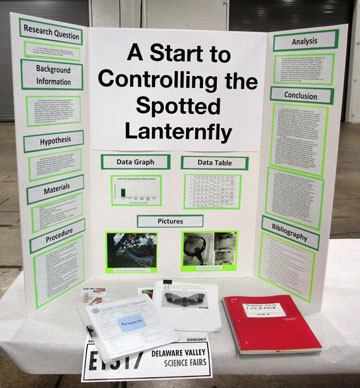CAROLYN
ALMONTE, RECEIVES
THE
AMERICAN ENTOMOLOGICAL SOCIETY’S 2019 CALVERT AWARD
There
was a
time when it was dark at night. However, with the ever increasing
outdoor
lighting, it is easy to get around in most populated areas on a
moonless night
without a flash light. This so called light pollution makes it hard to
see the
stars and may have other less apparent consequences. For example,
biologists
have noticed a dramatic long term decrease in the abundance of insects
that
cannot be easily explained. Older people remember the time when clouds
of moths
and other flying insects would be attracted to and swarm around street
lights
on warm summer nights. Now they say there are almost no insects around
those
lights. They talk of windshields covered with dead insects hit during
trips
that needed to be cleaned off at every stop for gas—not any more.
One
hypothesis
for disappearing insects is that the normal night-day cycle, on which
many
depend, has been disrupted, and they now effectively live in a world of
continuous light. This interested Carolyn Almonte, a tenth grade
student from
Burlington, New Jersey, who designed a science project to test the
hypothesis. Her
project, The Effect of Chronic
Exposure to
Artificial Light at Night on the Development and Fecundity of Manduca
sexta,
studied the tobacco hornworm moth. Each of
the six groups she raised throughout life cycle from egg to adult moth
was
exposed to a different level of light at night, except for one group
that was
kept dark. She measured a number of traits associated with reproductive
potential and found a consistent and significant negative impact of
light at
night that increased with light intensity. This supports her
hypothesis. Carolyn also received the first place award for 10 grade
Zoology and was 10th grade Bronze Metalist at the Delaware Valley
Science Fairs. She will be one of 12 students representing DVSF at the
Intel International Science and Engineering Fair in Phoenix, Arizona,
May 12-17, 2019.
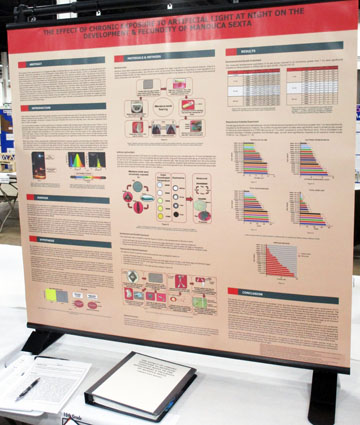
Carolyn
Almonte's Project displayed at the Delaware Valley Science Fairs
|
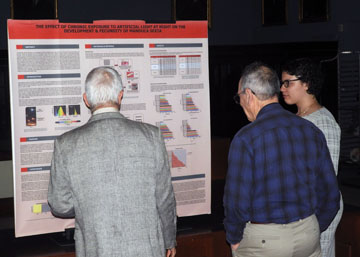
Carolyn Almonte describing her project to Jamie
Cromartie
and Kenneth Frank at the American Entomological Society meeting 24
April
|
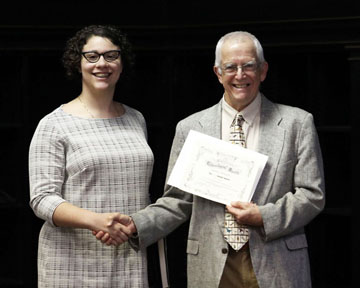
Carolyn Almonte Receiving 2019 Calvert Award
from Jamie Cromartie, AES President
|
Carolyn
displayed her project at the Delaware Valley Science Fairs on April 3.
From
among the 20 insect-related projects presented, the American
Entomological Society
awarded Carolyn its 33rd annual Philip P. Calvert Award which was
presented at the Society’s meeting held April 24
at the Academy of Natural Sciences of Drexel University in
Philadelphia. Dr. Jamie
Cromartie, president of the American Entomological Society, presented
Carolyn
and other honored students with checks, certificates of accomplishment,
and
membership in the Society.
Two other students earned
recognition, both for their interest in the Spotted Lanternflies, an
exotic
species that has invaded southeastern Pennsylvania and likely will
spread to
other areas with damaging effects on hardwood and fruit trees, and
vinyards.
Rachel Bergey,
an 8th Grade student from Harleysville, Pennsylvania, received
second place for her project, Spotted
Lanternflies: Sick’em or
Trick’em. She
developed methods to trap the Lanternflies that were feeding on trees
on her
family’s property. Rachel received other DVSF awards as well, including
an award from the Phildelphia Chapter of the \American Statistical
Association, Gold Metal for the Junior High Fair, and a second Place
FMC Award.
Rachel
Bergey's project was among the top 30 in the nation selected by
Broadcom for junior high science projects. As a finalist selected from
a pool of 300 previously selected from among 2300 projects, she went to
Washington DC for 6 days in October 25-30 where she emerged as one of
the 9 winners of the Broadcom
Masters competition!
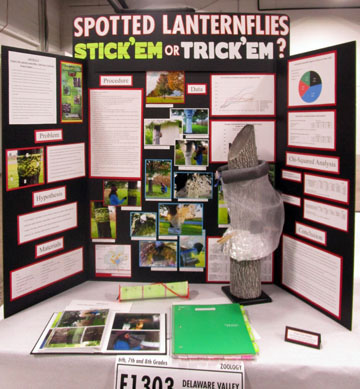
Rachel
Bergey's Project displayed at the Delaware Valley Science Fairs
|
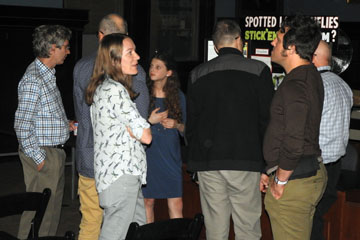
American Entomological Society members AES Members
gathered around Rachel Bergey and her Spotted Lanternfly project
|
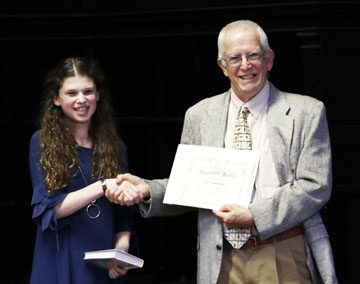
Rachel Bergey Receiving 2019 Calvert Award
from Jamie Cromartie, AES President
|
Jacquelyn
Fekula, an 8th
Grade student from Orefield, Pennsylvania,
received third place with
her
project, How does the Incubation of
Spotted Lanternfly Eggs affect
their
Hatching? She explored the effectiveness of various household
remedies
to kill
Lanternfly eggs.
|
Jacquelyn
Fekula's Project displayed at the Delaware Valley Science Fairs.
Jacquelyn was unable to attend the Calvert Award ceremonies due to a
prior commitment.
|
In 1987, the American
Entomological Society initiated the Calvert Award to be presented to a
young
person who has demonstrated outstanding accomplishments in
insect-related
study. The Award is named in honor of
Dr.
Philip P. Calvert who joined the Society as a teenager, later
became its
president, and was a member for 74 years.
As Professor of Biology at the University of Pennsylvania
and an Associate of the Academy of Natural Sciences of Philadelphia,
Dr.
Calvert played an important role in stimulating an interest in insects
among
young people.
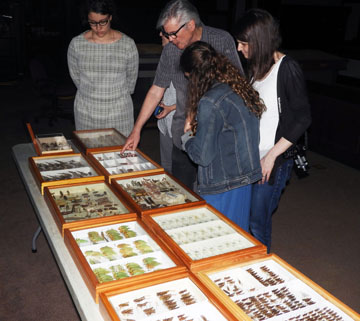
Greg
Cowper discusses the insect display to Carolyn Almonte and Rachel
Bergey at the AES Calvert Award meeting April 24, 2019.
|
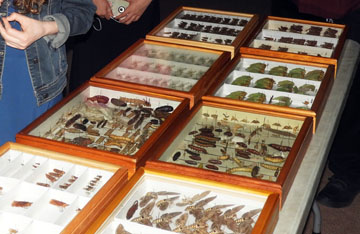
The insect display prepared by Greg Cowper for the
April 2019 AES meeting featured a variety of insects including: Spotted
Lanternflies and Manduca sexta, insects
studied by the Calvert awardees, insects that had been prepared by
Philip P. Calvert, and insects preyed upon by birds.
|
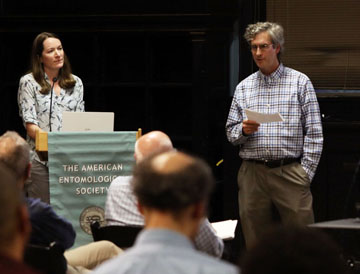
Charles Bartlett
introducing Ashley Kennedy, featured speaker at the April 2019 AES
meeting. Her graduate research at the University of Delaware involved a
crowd-sourced project and a related image capture study of the diet of
birds.
|
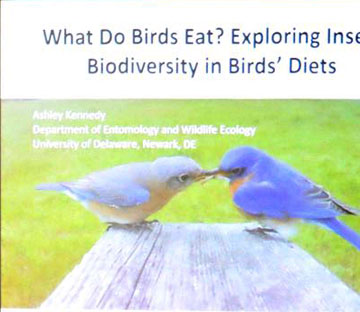
Ashley Kennedy's title slide for her talk. Check out
Ashley's What do
birds eat? Facebook page.
|
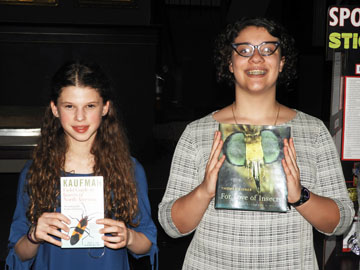
|
Rachel Bergey and
Carolyn Almonte displaying the books they
recieved as part of their 2019 Calvert Awards. This is the first year
that books have be part of the award. Rachel received a copy of
Kaufman's, Field Guide to Insects of North America.
Carolyn received a copy of For Love of Insects
by Thomas Eisner
|
Calvert
Award
Home Page
Created 27 January 2020, Last up dated 27 January 2020 by Hal White
[halwhite
at udel.edu]
Copyright
2019, The American
Entomological Society






